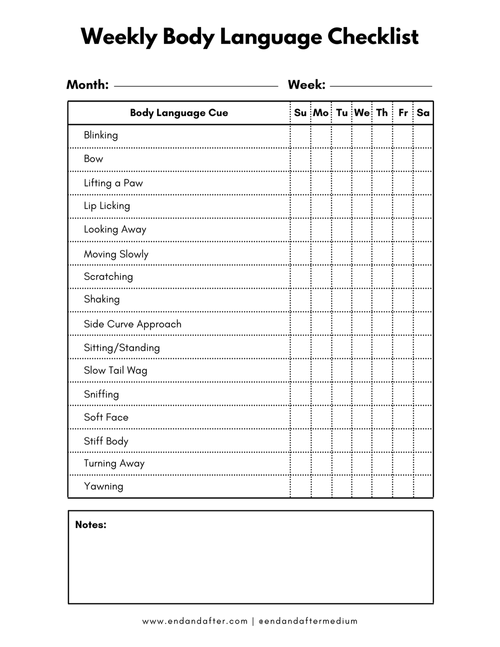Learn Your Pet's Distinct Body Language
Download The Weekly Body Language Checklist Below
We all want to better understand and relate to our pets and our pets do the best they can to navigate our world and language when they live with us. What we don't realize is the depths that our animals communicate back to us with their body. Becoming familiar with the role of their body language in your communication with them will ensure that their important messages won’t be missed. By improving your awareness and making a few simple changes you will have the power to make a shift in your communication and deepen your ability to better understand your pet.
Making The Communication Tangible
In my experience as an animal communicator I have learned that pet parents want to have something tangible to help them understand their pet when they are communicating with them. In my sessions, I noticed animals were giving body responses when I was sharing their messages with their person. I started asking clients to observe their pet’s body responses during our sessions. When they witnessed their pet responding with body cues, it made the parallels of the communication tangible and it validated the messages their pets had to share. This opened the door for my clients to understand how much their pet truly understood.
Some animals have a favourite body cue they like to use, and others use different cues each time. Learning your pets distinct body language and how they use it in their communication with you begins with one simple, yet essential step : OBSERVATION.
Begin Observing
Make a point to begin observing your animal. Take two to five minutes at a time where you give your full focus to simply observing them. Only observe, don’t interpret. And I recommend starting in your home and not speaking with them. Also, consider taking a video recording of your animal. You'll discover more when you actually watch it back in slow motion. The slow motion helps you see what you miss in real time as their body language is so fast and subtle.
How do they move? How are they related to their surroundings and other animal companions. How do they relate to you and other family members?
Some of the signs I see most often in my practice, and you’ll want to look for, include the turning of their head and looking away, sighing, lip licking, licking or grooming, and yawning. I have observed these signs and responses in dogs, cats, and horses.
When you are observing your pet make sure to write down what body language you see over the next week and briefly jot down the situation or interaction that it occurred in. I have created a print out for you at the bottom of blog to help you track which body language you observe and how often.
Set an Intention of Understanding
Sometimes our animals actively use their body to communicate with us and other times not as much. There are also animals that either respond with very subtle cues or even not at all. Know that this is okay. What you are trying to do with this practice is just observe so you can understand your pet better. This isn’t a time for judgment or comparison. Your desire to want to understand them will help them open up and become more comfortable using their body language to communicate with you. Remember each animal is an individual. They have their own skills and experiences and unique ways of communicating with you using their body.
You didn't learn to speak your native tongue in an hour or a day. You learned to speak over several years, so learning your animal's body language cues will be no different. This is a practice that you will want to revisit with your pet as the communication between you changes and evolves.
The Free Weekly Body Language Checklist
The Weekly Body Language Checklist contains the main body language cues I see in my animal communication practice. It will help you keep track of which body language cues you observe, and identify which cues your pet is using on a regular basis. In the Note section, identify the types of situations and interactions your pet was in while observing them. DOWNLOAD NOW
Would you like to read more like this? I recommend using the tags below to check out similar blogs OR follow this link to check out our #animalcommunicationtipsea posts on Instagram @endandaftermedium
Do you want to learn more about how your pet communicates with you?

